#tungusic
Text
Fishskin Robes of the Ethnic Tungusic People of China and Russia
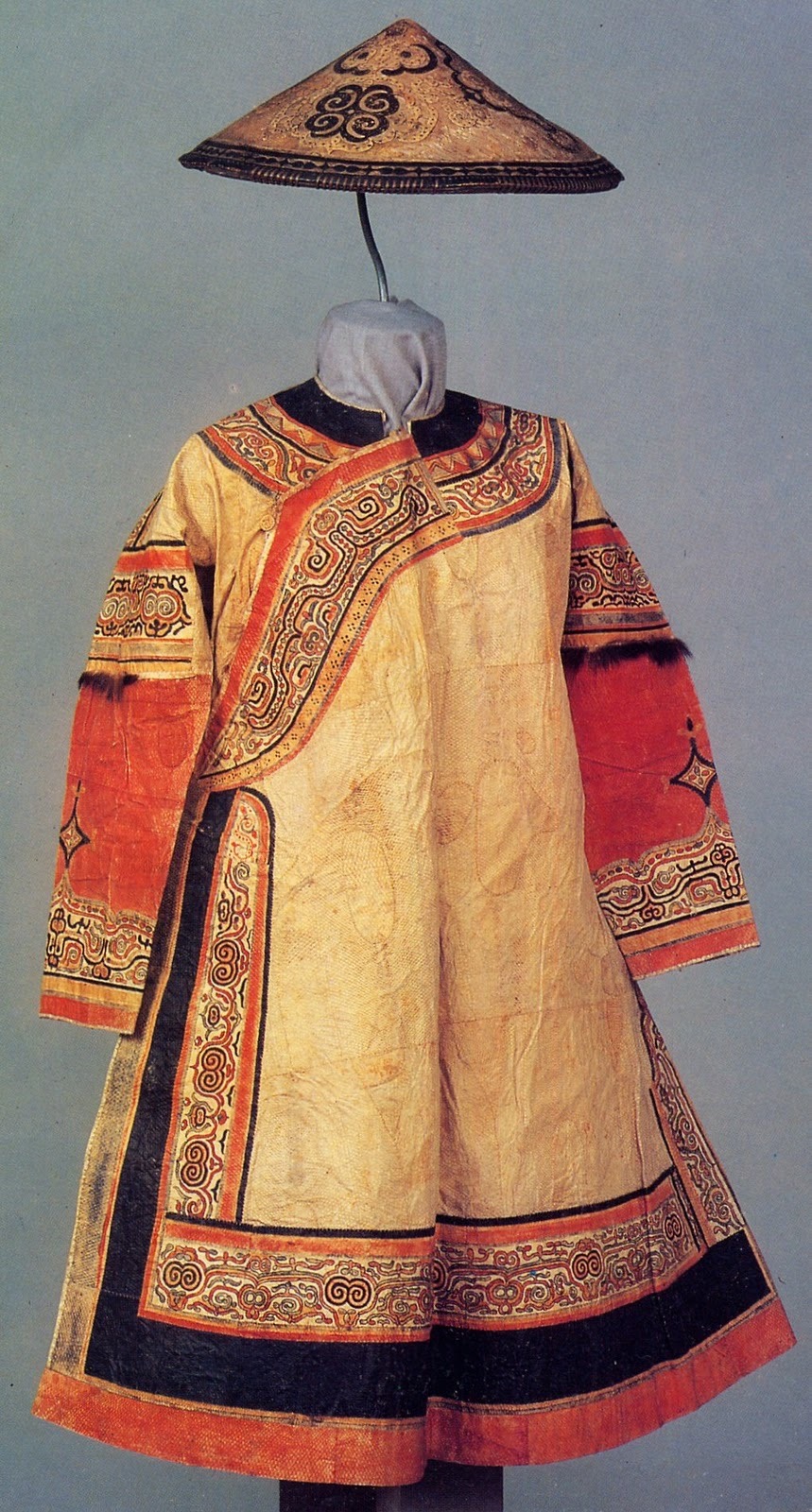
Oroch woman’s festive robe made of fish skin, leather, and decorative fur trimmings [image source].
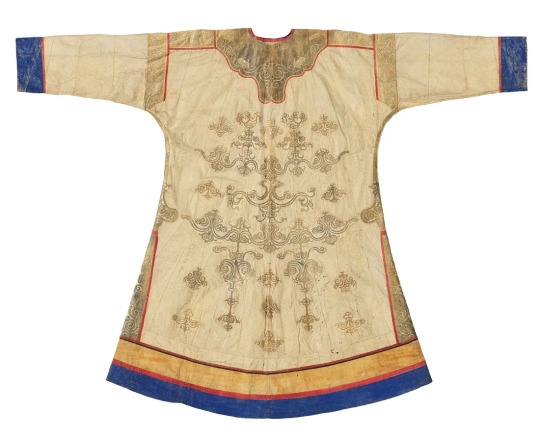
Nivkh woman’s fish-skin festival coats (hukht), late 19th century. Cloth: fish skin, sinew (reindeer), cotton thread; appliqué and embroidery. Promised gift of Thomas Murray L2019.66.2, Minneapolis Institute of Art, Minnesota, United States [image source].
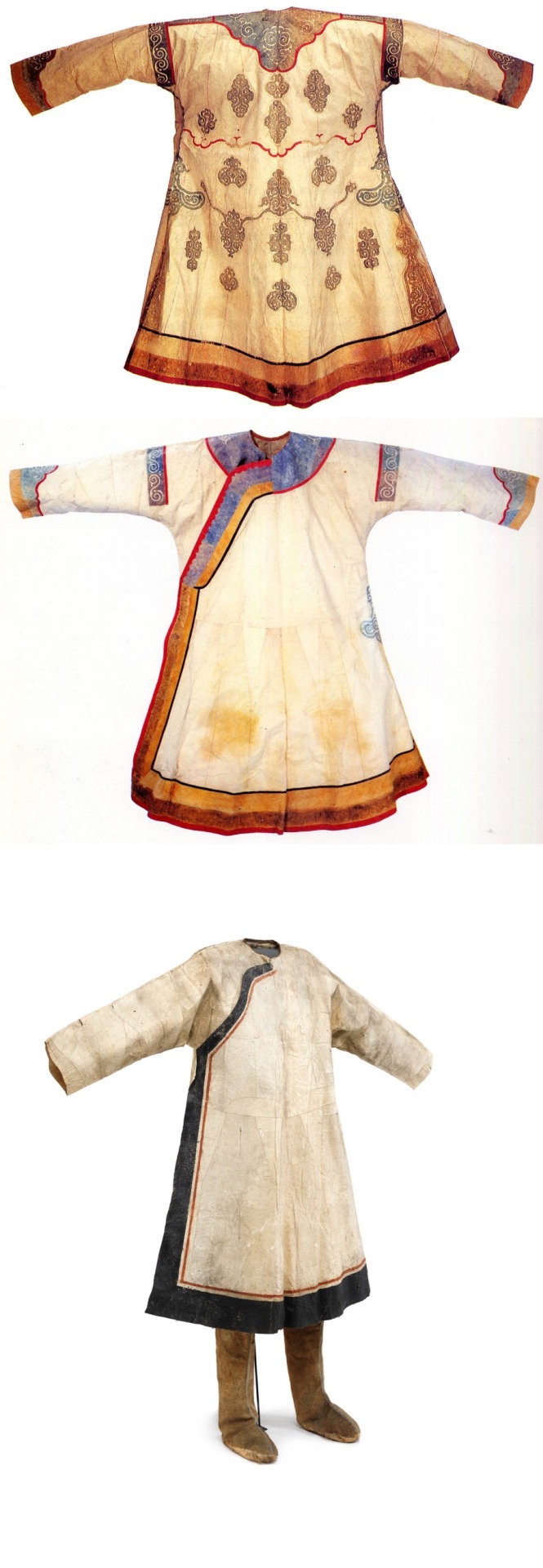
Back view of a Nivkh woman’s robe [image source].
Front view of a Nivkh woman’s robe [image source].
Women’s clothing, collected from a Nivkh community in 1871, now in the National Museum of Denmark. Photo by Roberto Fortuna, courtesy Wikimedia Commons [image source].
The Hezhe people 赫哲族 (also known as Nanai 那乃) are one of the smallest recognized minority groups in China composed of around five thousand members. Most live in the Amur Basin, more specifically, around the Heilong 黑龙, Songhua 松花, and Wusuli 乌苏里 rivers. Their wet environment and diet, composed of almost exclusively fish, led them to develop impermeable clothing made out of fish skin. Since they are part of the Tungusic family, their clothing bears resemblance to that of other Tungusic people, including the Jurchen and Manchu.
They were nearly wiped out during the Imperial Japanese invasion of China but, slowly, their numbers have begun to recover. Due to mixing with other ethnic groups who introduced the Hezhen to cloth, the tradition of fish skin clothing is endangered but there are attempts of preserving this heritage.
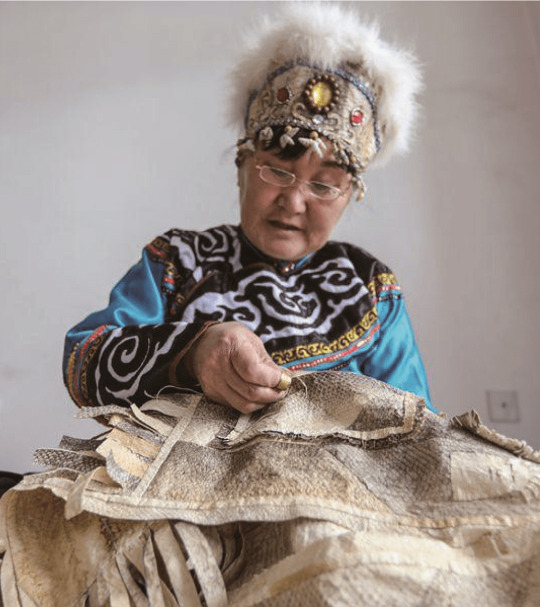
Hezhen woman stitching together fish skins [image source].


Top to bottom left: You Wenfeng, 68, an ethnic Hezhen woman, poses with her fishskin clothes at her studio in Tongjiang, Heilongjiang province, China December 31, 2019. Picture taken December 31, 2019 by Aly Song for Reuters [image source].
Hezhen Fish skin craft workshop with Mrs. You Wen Fen in Tongjian, China. © Elisa Palomino and Joseph Boon [image source].
Hezhen woman showcasing her fishskin outfit [image source].
Hezhen fish skin jacket and pants, Hielongiang, China, mid 20th century. In the latter part of the 20th century only one or two families could still produce clothing like this made of joined pieces of fish skin, which makes even the later pieces extremely rare [image source].
Detail view of the stitching and material of a Hezhen fishskin jacket in the shape of a 大襟衣 dajinyi or dajin, contemporary. Ethnic Costume Museum of Beijing, China [image source].
Hezhen fishskin boots, contemporary. Ethnic Costume Museum of Beijing, China [image source].
Although Hezhen clothing is characterized by its practicality and ease of movement, it does not mean it’s devoid of complexity. Below are two examples of ornate female Hezhen fishskin robes. Although they may look like leather or cloth at first sight, they’re fully made of different fish skins stitched together. It shows an impressive technical command of the medium.
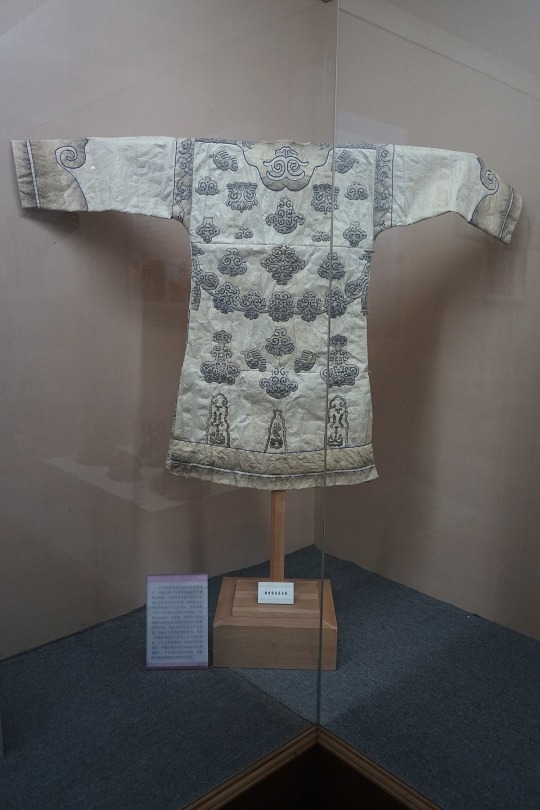
赫哲族鱼皮长袍 [Hezhen fishskin robe]. Taken July 13, 2017. © Huanokinhejo / Wikimedia Commons, CC BY 4.0 [image source].
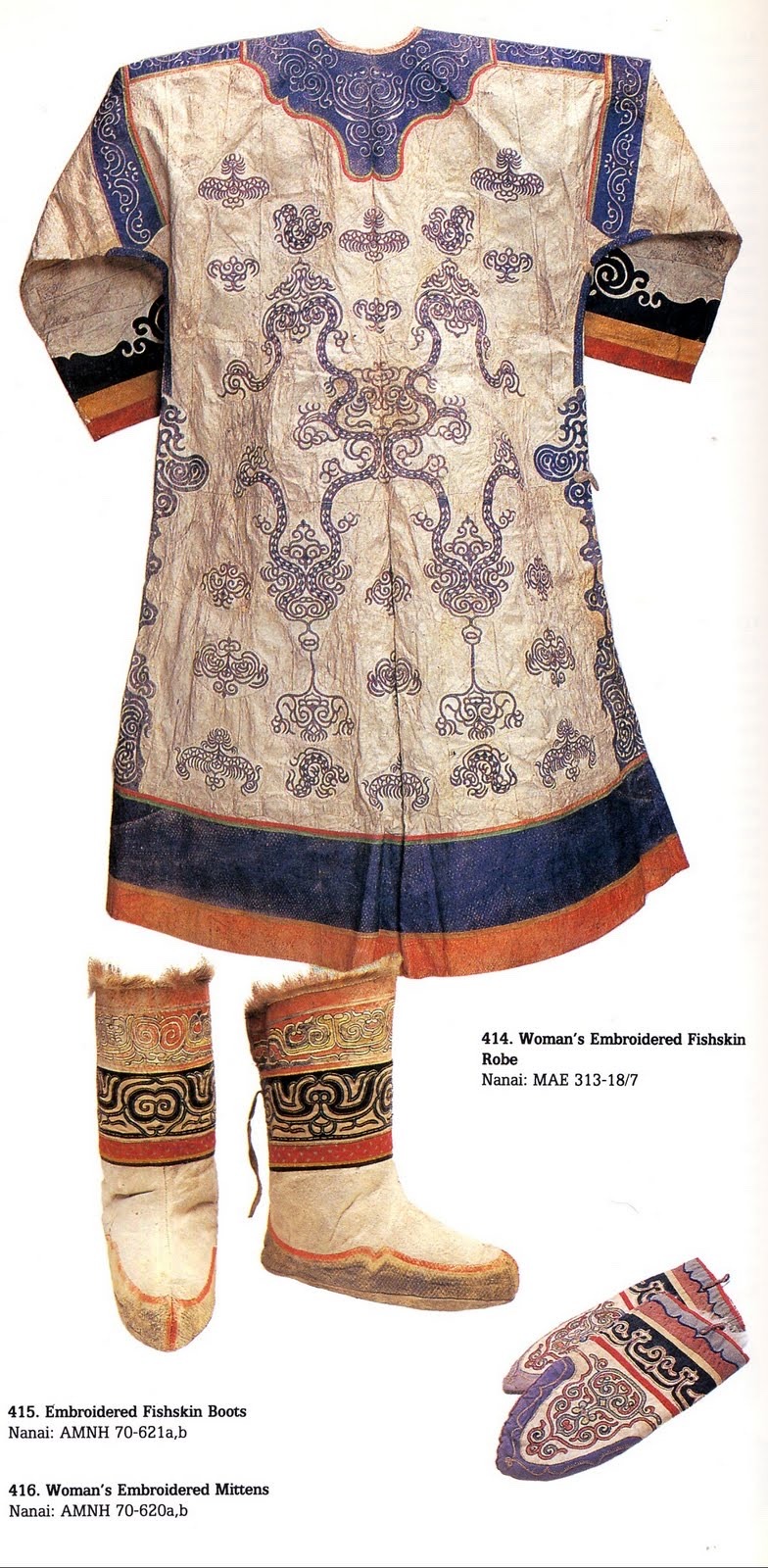
Image containing a set of Hezhen clothes including a woman’s fishskin robe [image source].
The Nivkh people of China and Russia also make clothing out of fish skin. Like the Hezhen, they also live in the Amur Basin but they are more concentrated on and nearby to Sakhalin Island in East Siberia.


Top to bottom left: Woman’s fish-skin festival coat (hukht) with detail views. Unknown Nivkh makers, late 19th century. Cloth: fish skin, sinew (reindeer), cotton thread; appliqué and embroidery. The John R. Van Derlip Fund and the Mary Griggs Burke Endowment Fund; purchase from the Thomas Murray Collection 2019.20.31 [image source].
Top to bottom right: detail view of the lower hem of the robe to the left after cleaning [image source].
Nivkh or Nanai fish skin boots from the collection of Musée du quai Branly -Jacques Chirac. © Marie-Lan Nguyen / Wikimedia Commons, CC BY 4.0 [image source].
Detail view of the patterns at the back of a Hezhen robe [image source].
Read more:
#china#russia#tungusic#hezhe#nanai#fishskin#ethnic minorities#nivkh#chinese culture#history#russian culture#amur basin#heilongjiang#east siberia#ethnic clothing
974 notes
·
View notes
Text
"IE is hard because you need to learn German to understand 75% of the literature" there's worse, like Tungusic where it's evenly split between German, Russian, Chinese, Finnish, and English.
52 notes
·
View notes
Text
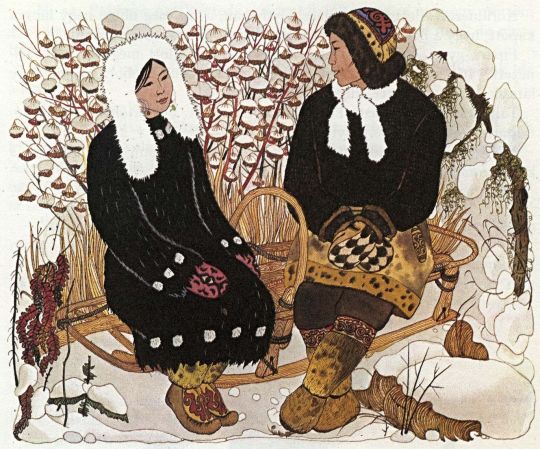


Иллюстрации "Чориль и Чольчинай". Нанайская сказка
Illustrations "Choril and Cholchinay". Nanai fairy tale
Illustrator Gennady Pavlishin
Иллюстратор Генадий Павлишин. Из "Амурские сказки" 1975
#Amur#tungusic#indigenous russia#indigenous russian#non-russian#Nanai#Нанайцы#Nanai culture#Культура Нанайцы#artist#art
601 notes
·
View notes
Text
TURKIC RESOURCES
The Anthropological Masterlist is HERE.
The Turkic people are a Eurasian people that speak a Turkic language.
ALTAI ─ “The Altai people are a Turkic people. They are native to the Altai Republic in Russia.”
─ Altai Religion from the 1890s to the 1920s
─ Altai Language (in Russian)
CHUKCHI ─ “The Chukchi, or Chukchee, people are an Indigenous Russian people. They are native to the Chukchi Peninsula in Russia.”
─ Chukchi Information
─ Chukchi Mythology
─ Chukchi Language
CHUVASH ─ “The Chuvash people are a Turkic people. They are native to the Volga-Ural region of Siberia.”
─ Chuvash Culture & Dictionary
─ Chuvash History
─ Chuvash Phonetics
KOMI ─ “The Komi people are a Permian people. They are native to northeast European Russia, around the basin of the Pechora river.”
─ Permian Komi History
─ Permic Script
TATAR ─ “The Tatar people are a Turkic people that share the Tatar language. Historically, it was also used to refer to people that came from Tatary.”
─ Volga Tatars
─ Crimean Tatars (in Russian)
─ Tatar Language Dialects (in Russian)
TUNGUSIC ─ “The Tungusic people are a Tungusic people. They are native to Siberia and northeast Asia.”
─ Manchu-Tungusic People
TURKIC ─ “The Turkic people are an ethnic group that consists of anyone that speaks Turkic languages. They are native to many parts of Asia and Europe.”
─ Literature of the Central Asian Turkics
─ Turkic Mythology
─ The Turkic Expansion
TURKISH ─ “The Turkish, or Turk, people are a Turkic people. They are native to Turkey and northern Cyprus.”
─ Turkish Culture
─ The Ottoman Empire
─ Turkish Dictionaries
YAKUT ─ “The Yakut, or Sakha, people are a Turkic people. They are native to the Republic of Sakha in Russia.”
─ Yakut Information
─ The Yakut under Soviet Rule
─ Sakha Dictionary
194 notes
·
View notes
Text
Alexander Vovin “Towards a New Classification of Tungusic Languages” (1993)
This paper [Vovin, Alexander. "Towards a new classification of Tungusic languages." Eurasian Studies Yearbook 65 (1993): 99-113] is an attempt at a lexicostatistical classification of Tungusic. Based on percentages of cognates in 100 word Swadesh lists, Vovin proposes the following classification:

A strikingly unusual feature of this tree is the position of Even as the second language to branch off after Manchu. Usually, Even is placed in the same branch with Evenki, Solon, Oroqen and Negidal.
Indeed, Even mostly shows lower cognate percentages with other Tungusic varieties than any other language save Manchu:

It would be interesting to check the accuracy of Vovin’s wordlists, but I will not try to do it here. Instead, we can look at some of those items of the Swadesh lists where Even differs from other languages. These are the very items which cause lower cognate percentages.
‘blood‘: Even huneel [actually huŋeel] vs. reflexes of *sääksä in all other languages (Manchu senggi contains a different suffix, but has the same root)
‘bone‘: Even ikeri with a cognate in Negidal vs. reflexes of *gïramsa in all other languages (Manchu giranngi contains a different suffix, but has the same root)
‘die‘: Even køke= vs. reflexes of *bö(d)- in all other languages, including Manchu
‘drink‘: Even kool= vs. reflexes of *umï- in all other languages, including Manchu
‘ear‘: Even korat with an apparent cognate in Udihe vs. reflexes of *sian in all other languages, including Manchu
‘full‘: Even milteree vs. reflexes of *ǯalo- in all other languages save Udihe
‘sleep‘: Even huklee= vs. reflexes of *au- in all other languages, including Manchu
‘sun‘: Even nøølten vs. reflexes of *sigöön in all other languages, including Manchu (Evenki, Solon & Negidal also reflect another root: *dïlačaa)
This is not a pattern we would expect from a second outlier in the family. One could rather expect that Even would share some archaisms with Manchu as against innovations in the common ancestor of all remaining languages. There are no such cases in the Swadesh list. Instead, we see Manchu sharing common words with the rest of the family except Even. Given that Manchu is the first outlier in Vovin’s classification (as well as in most other classifications), words shared by Manchu with other languages are by definition archaisms, while isolated Even words must be innovations.
The position of Even in Vovin’s tree is clearly erroneous. The reason for this error is the fact that lexicostatistics does not distinguish between archaisms and innovations, so that a lexically innovative language may look like an outlier in a family.
30 notes
·
View notes
Text
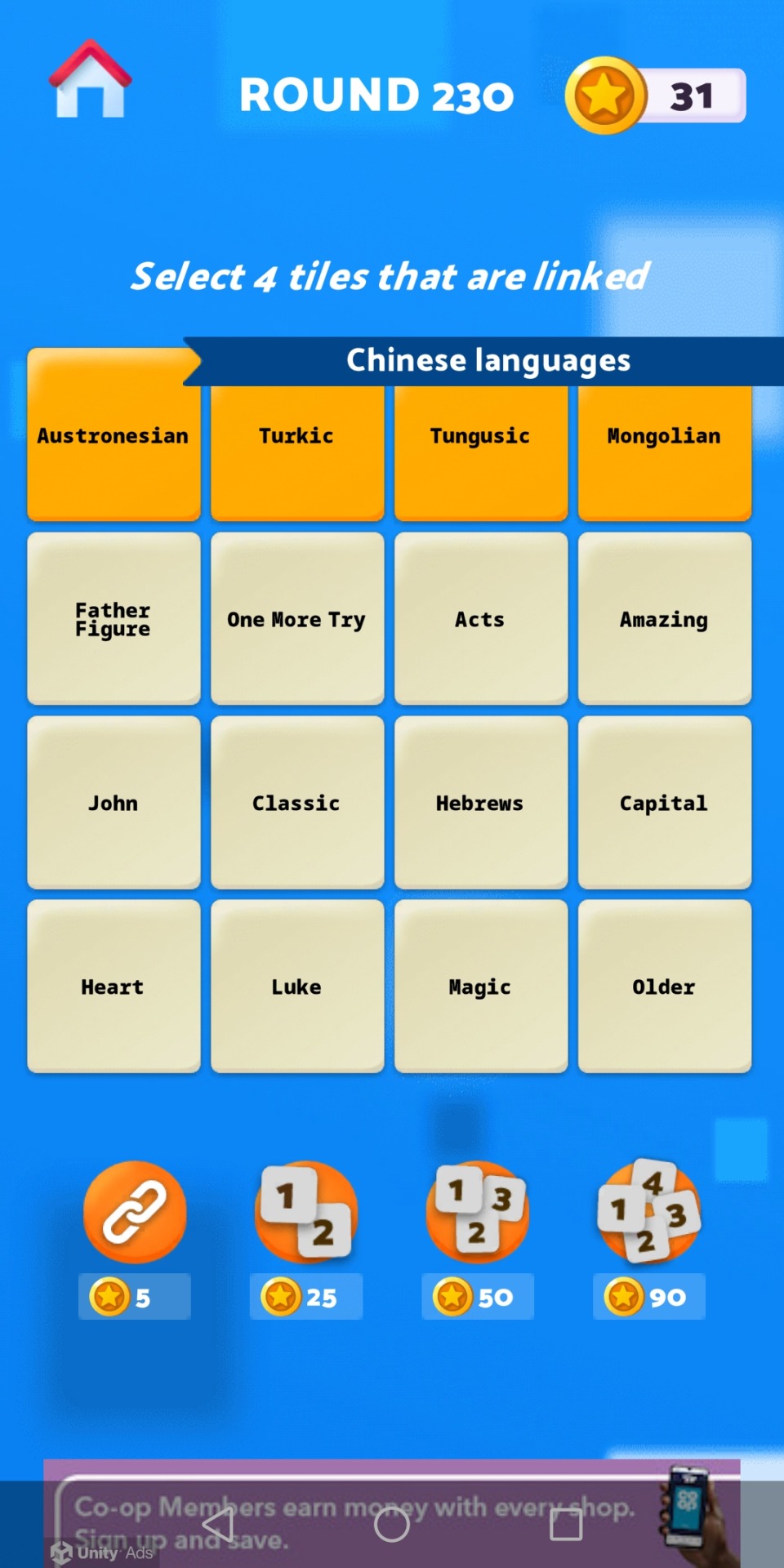
I guess all languages descend from Chinese now
#linguistics#languages#Langle#chinese#only connect#austronesian#turkic#tungusic#mongolian#it's all chinese to me
1 note
·
View note
Text
Hot siren gets her giant boobs and pierced cunt massaged
Mi amiga de Durango
Barranquillera
Japanese gf with long legs in pantyhose gets fucked
MinnieeXTC MILF se exibindo no Periscope
Young straight boy fucking clips and penis boys galleries gay
Senora piernas gruesas espiada
Please let me out of these handcuffs JOI
Skinny Japanese MILF amateur gets toyed and fucked
Desi Bhabi First Time Sex
#Sabuja#Isidora#Tungusic#geds#oppressing#studioghibliedit#Cousins#counter-party#Parthenolatry#conservations#giftedness#teazling#Begoniaceae#elatives#Zsolway#Ikaria#adnate#Mammut#priesting#unperfect
0 notes
Text
Jane Wilde slides her soft tongue up and on Alexis Fawx wet pussy
Nenita violada chavita le meto la verga
Old naked men outdoors and of cocks balls in public gay Anal Sex In
SEXY DOMINICAN BITCH KARY PLAYING WITH HER PUSSY
Big tit bikini bombshell gags on hard cock
Asian Girl with socks gets fucked by Spanish Boyfriend
Teen gets eaten out and plowed by stepbro
cogida flaca
stepmom wants my big dick with anal plug and cum on face
Indian aunty fuck hard
#sea-monk#innuate#glutamic#bountyless#gramp#interview#tetradrachmon#Adalie#unencrypted#three-month#mecodont#Bedlamic#Sabuja#Isidora#Tungusic#geds#oppressing#studioghibliedit#Cousins#counter-party
0 notes
Photo

Got bored so designed a flag with Tungusic people in mind. Don’t yet know what would be the vexillological meaning of it, but it’s cool i guess
1 note
·
View note
Photo
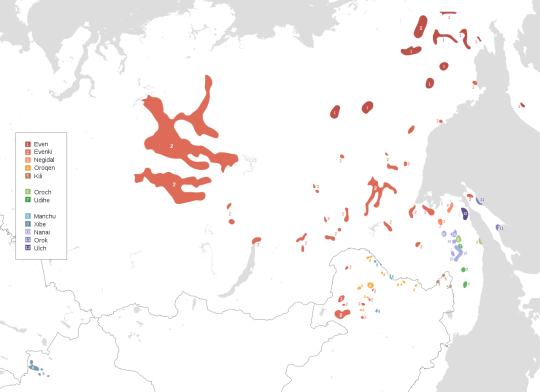
Areas Where Tungusic Languages Are Spoken Today
70 notes
·
View notes
Text
Regular reminder that "Celtic shamanism" doesn't exist. It never did.
Whatever the Celts were doing, it wasn't "shamanism" and it'll never be.
Shamans are Tungusic. End of story.
#witches of color#witchblr#paganblr#cultural appropriation#closed practices#shamanism#tungusic people#misinformation
111 notes
·
View notes
Text

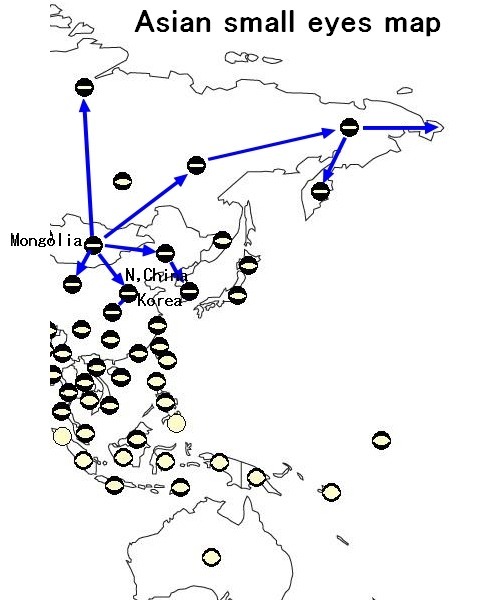
Average Human Eye Size Map
#small eyes#asian eyes#tungusic peoples#mongolian#mongol empire#siberian#russia#northern chinese#korean#kpop#Immigrant Invasion#study abroad#information#sightseeing#travel#trip
2 notes
·
View notes
Text
youtube
1 note
·
View note
Text


Иллюстрации "Как бельды воевать ходили". Нанайская сказка
Illustrations "How Beldy went to fight". Nanai fairy tale
Illustrator Gennady Pavlishin
Иллюстратор Генадий Павлишин. Из "Амурские сказки" 1975
#Amur#tungusic#indigenous russia#indigenous russian#non-russian#Nanai#Нанайцы#Nanai culture#Культура Нанайцы#artist#art
268 notes
·
View notes
Text
threesome with mature mom
Hot indian teen gf fucking pussy mala Patel
Masterbated on the bus
Cute skinny teens posed at a outdoor photo session
Novinha Tomando banho caiu na net
Me doy nalgadas
Thai sexy santa girl fucking get a creampie. thai teen fucking doggystyle wet pussy.
Big tits emo and her girlfriend doing bareback
Slut gets picked up and has her face fucked in a bus
MILFGonzo Kendra Lust has her pussy impaled by young stud
#Tunguses#Aspers#Monostomum#individual's#gauffering#abnegators#psychometric#first-named#Welkom#ballotage#pavises#Trichoderma#negative#chevies#salariats#Cindra#avantgarde#vicarial#bizarrely#voodoo
0 notes
Text
Lindsay J. Whaley and Fengxiang Li “Oroqen Dialects”
This paper surveys some dialectal data from Oroqen varieties. Authors conclude that Oroqen can be divided into the following four dialects: Western, Central, Northeastern, and Southeastern.
One of the phonological developments distinguishing Oroqen dialects is what Whaley & Li call “manifestation of *-ld-”:

At first sight it seems like *-ld- is simplified to -l- in all dialects, save Western. However, things are somewhat more interesting.
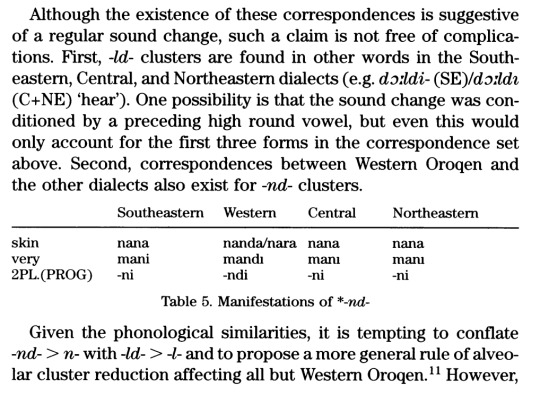

This discussion shows a lack of familiarity with the most basic facts of Proto-Tungusic reconstruction. The words in Tables 4 & 5 do not reflect Proto-Tungusic *-ld- and *-nd-. Instead, they reflect *-ls- and *-ns-! Cf. the following Proto-Tungusic reconstructions (I use Doerfer’s system here, but the correspondences for *ls and *ns were recognized as such already by Tsintsius): *ölsä ‘meat’, *pulsa ‘quilt’, *nansa ‘skin’, *mansï ‘very’, *-nsi ‘2 sg’ (2PL in Table 5 must be a mistake) vs. *dooldï- ‘to hear’. The verb ‘to sing’ is more complicated: apart from Oroqen, it has reflexes in Ewenki, Solon and Ewen (thus, only in North Tungusic), and the Proto-North-Tungusic form can be reconstructed as *ǯaandaa-. However, one of the common North Tungusic innovations is the simplification *-nd- > *-n-, so Proto-North-Tungusic *-nd- must have a different source. Perhaps, this word is a loan from unknown source, borrowed after the change *-nd- > *-n-.
An interesting feature of Oroqen is its symmetrical vowel system with tense (+ATR) / lax (-ATR) pairs:

Southeastern Oroqen differs from other dialects by merging /i/ and /ı/:

The authors point out that “An even more dramatic restructuring of the vowel harmony system has occurred in most Tungusic languages. Only Oroqen and Solon seem to have preserved a perfect symmetry between tense and lax pairs, except now for the Southeastern dialect, where the system is moving toward asymmetry”.
Indeed, Proto-Tungusic is reconstructed with a very similar symmetrical system: +ATR *i, *ii, *ü, *üü, *ä, *ää, *ö, *öö, vs. -ATR *ï, *ïï, *u, *uu, *a, *aa, *o, *oo + some diphthongs. A common innovation of North Tungusic languages (including Oroch and Udihe) is a change *ü > *i, *üü > *ii, so Oroqen symmetrical system cannot directly continue the Proto-Tungisic vocalism. While Oroqen /u/ continues Proto-Tungusic *ö (e.g., in Oroqen urə ‘mountain’ < PT *xörää ‘id.’), the origin of Oroqen /o/ remains unclear to me. Oroqen words cited in the article do not contain this phoneme.
25 notes
·
View notes